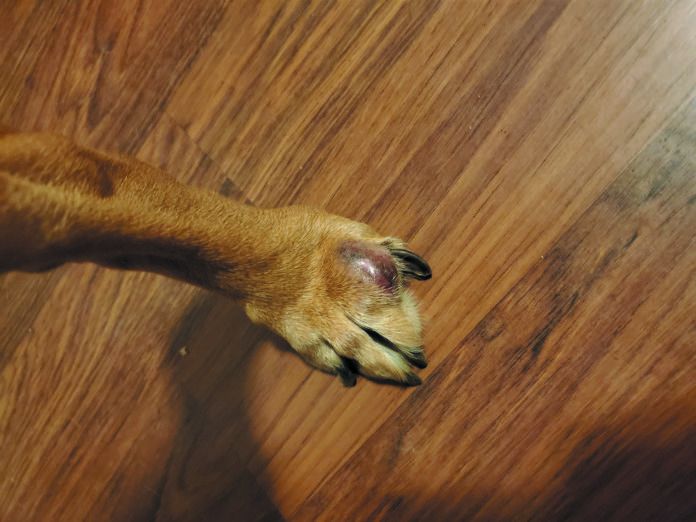It looks like a nasty red bump between two toes. You’ll tend to see one on larger breed dogs — Labrador or golden retrievers, English bulldogs, pit bull terriers. But cocker spaniels and pugs get them, too, and in fact no breed is immune. Medically, they’re called interdigital cysts — interdigital meaning that they’re between the digits, or toes. And they occur with some frequency. Why do they form?
“It’s a tricky condition because it’s not always easy to identify the primary cause,” says Tufts veterinary dermatologist and Your Dog editorial board member Ramón Almela, DVM. “One theory is that any trauma or rupture to the hair follicles in the feet can lead to an inflammatory cascade that results in the cysts. The protein keratin present in the hair follicles, when released, acts as a foreign body” that causes problems.
But there are many reasons a hair follicle may rupture in the first place. For instance, there’s the pressure of excess weight. It doesn’t have to be that a dog is overweight, Dr. Almela says. Sometimes the feet may be malpositioned in a way that puts extra pressure on the follicles in a small area of the foot — you might not be able to see the malpositioning just by looking. Some dogs may be particularly sensitive to even just a slight positioning problem that doesn’t change how they walk or run.
An allergy or infection could also potentially make hair follicles rupture on the feet. With an allergy, a dog’s feet will feel itchy, so he will start to lick and chew his paws, thus traumatizing the hair follicles and causing them to break open. And an infection can destroy a hair follicle outright, leading to subsequent inflammation.
Whatever the primary cause, the rupturing of follicles can make a dog feel even itchier or even cause pain on the affected feet. Thus, there’s further persistent licking of the paws to relieve the itch or pain. That, in turn, can exacerbate the inflammatory effect, making for a vicious cycle.
Getting to the root cause and the optimal treatment
In order to treat the problem, the doctor has to work backwards to see what might be causing the hair follicles to rupture. And he has to look at a couple of things at once.
“Allergies are one of the main causes of interdigital cysts,” Dr. Almela says, so you want to see if there’s something in the dog’s environment, or perhaps his food, to which he has an allergic reaction and which can be removed or treated effectively with medication. But that takes some time, and because you want to put a stop to the dog’s discomfort, it’s also important to see if there’s an infection, and if so, what kind of bacteria is causing it.
As with many other situations, you can’t just prescribe a basic antibiotic and assume it will take care of whatever infection is present, Dr. Almela says. “In the last years, the bacterial resistance to antibiotics has increased dramatically, so in general it is highly recommended that you really work to match the antibiotic to the problem” with cytology [examining cells under a microscope] or by performing a culture to see exactly what kind of bacteria are growing. “Sometimes the infection is very deep,” the doctor says, which is also why you have to make sure that if an antibiotic is needed, the right one is prescribed to kill the bacteria that are so embedded.
Whether the cause of the cyst is an infection, an allergy, or weight that puts extra pressure on the hair follicles, the veterinarian may very well prescribe an anti-inflammatory medication to help take down the swelling. “It can’t be just an NSAID. They are usually ineffective at controlling this problem,” Dr. Almela says. “It will have to be more potent.”
Because it’s often hard to pin down what’s causing the hair follicles to rupture and lead to the cyst-forming inflammation, “there’s no definite protocol. Decisions are made case-to-case” as far as what steps to take in what order, Dr. Almela says.
But with concerted sleuthing that leads to the proper medical protocol — along with a little patience on your part — the doctor should be able to help a dog get ahead of the problem.






My silver lab, 2.5 yrs old, has 2 cysts between his 1st and 2nd toes of left back foot. He does lick the area sometimes , but not obsessively. I have a vet apt for this to be evaluated, but not for another 1.5 weeks. He is very active, walking at least 1 hr a day and playing fetch with a ball launcher for 30 min a day. He needs this exercise to stay happy. His foot doesn’t seem to bother him while walking or playing ball. Is it ok to keep him active until he sees the vet? Can I do anything to help with the cysts until he is evaluated? Thank you. Mary Kagan